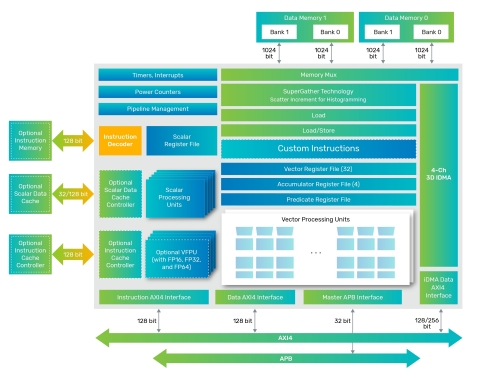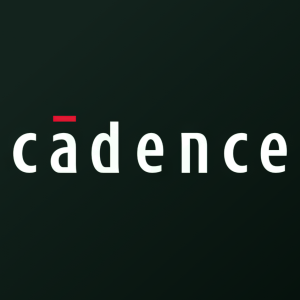Cadence Extends Popular Tensilica Vision and AI DSP IP Product Line with New DSPs Targeting High-End and Always-On Applications
Cadence Design Systems (Nasdaq: CDNS) has launched two new DSP IP cores: the Tensilica Vision Q8 and Vision P1, enhancing its DSP product family for embedded vision and AI. The Vision Q8 delivers an impressive 3.8 TOPS, doubling performance and memory bandwidth over its predecessor, while the Vision P1 is optimized for low-power, always-on smart sensor applications. Both DSPs support various programming models and certifications, catering to automotive and consumer markets. The Vision Q8 is available now, with the Vision P1 set for release in Q2 2021.
- The Tensilica Vision Q8 DSP achieves 3.8 TOPS, doubling performance and memory bandwidth compared to the Vision Q7 DSP.
- The Vision P1 DSP is optimized for low-power applications, providing a third of the power usage compared to its predecessor.
- Strong customer interest is indicated with multiple evaluations underway for the new DSPs.
- None.
Cadence Design Systems, Inc. (Nasdaq: CDNS) today expanded its popular Tensilica® Vision DSP product family with the debut of two new DSP IP cores for embedded vision and AI. Packing an industry-leading 3.8 tera operations per second (TOPS), the flagship Cadence® Tensilica Vision Q8 DSP delivers 2X performance and memory bandwidth compared to the Tensilica Vision Q7 DSP and energy efficiency for high-end vision and imaging applications in the automotive and mobile markets. The Tensilica Vision P1 DSP is optimized for always-on and smart sensor applications in the consumer market, providing an energy-efficient solution.

Packing an industry-leading 3.8 tera operations per second, the flagship Cadence Tensilica Vision Q8 DSP delivers 2X performance and memory bandwidth compared to its predecessor plus energy efficiency for high-end vision and imaging applications in the automotive and mobile markets. (Graphic: Business Wire)
There has been strong customer interest in the Vision Q8 and Vision P1 DSPs, with several evaluations underway. The new DSPs round out Cadence’s comprehensive portfolio of proven vision and AI DSPs, offering customers even greater design flexibility with best-in-class technology. For more information, visit www.cadence.com/go/VisionQ8P1.
Based on the similar SIMD and VLIW architecture found in the existing Tensilica Vision DSPs, the Vision Q8 and Vision P1 DSPs feature an N-way programming model that preserves software compatibility for an easy migration from prior-generation Tensilica Vision DSPs with different SIMD widths. Like the rest of the Tensilica Vision DSP family, the Vision Q8 and Vision P1 DSPs support Tensilica Instruction Extension (TIE) language, allowing customers to customize the instruction set. Both DSPs also support Xtensa® Neural Network Compiler (XNNC) and the Android Neural Networks API (NNAPI) for neural network support. In addition, they support more than 1700 OpenCV-based vision library functions, OpenCL and the Halide compiler for computer vision and imaging applications. Both cores are automotive ready with ASIL B hardware random faults and ASIL D systematic fault certification.
The seventh-generation Tensilica Vision Q8 DSP also offers the following features and capabilities:
- Optimized for high-end mobile and multi-camera automotive applications
- 1024-bit SIMD with 3.8TOPS delivers 2X performance for vision, AI and floating point and 2X memory bandwidth compared to the Vision Q7 DSP
- Single core simplifies system design, reducing power by up to 20 percent
- Delivers up to 4X performance improvement for non-convolution layers for AI workload
- Expanded instruction set provides high-level language support for OpenCL and Halide, and simplified programming model shortens time to program so code can be written once and utilized across different SIMD widths
Tensilica Vision P1 DSP features and capabilities include:
- Optimized for always-on applications including smart sensors, AR/VR glasses and IoT/smart home devices
- 128-bit SIMD with 400 giga operations per second (GOPS) offers one-third the power and area plus 20 percent higher frequency compared to the widely deployed Vision P6 DSP
- Architecture optimized for small memory footprint and operation in low-power mode
“The sheer number of sensors, as well as demands for higher frames per second and resolution, are driving the need for high-performance vision and AI DSPs that support a variety of data types,” said Sanjive Agarwala, corporate vice president and general manager of the IP Group at Cadence. “At the same time, the market also needs low-power vision DSPs with entry-level AI support for always-on smart sensor applications. With the introduction of the Tensilica Vision Q8 and Vision P1 DSPs, Cadence offers our customers optimal flexibility and faster time to market with a comprehensive portfolio of vision and AI DSPs from the high end to the low end.”
Industry Analyst Quotes
“The use of 3D sensors and different types of sensor technology continues to grow in the mobile, automotive and AR/VR markets,” said Mike Demler, senior analyst at the Linley Group. “All of these markets are increasingly demanding high-performance vision and AI processing with low power for edge applications. To meet these requirements, SoC designers are seeking hardware IP with a range of performance points. Cadence has a proven track record of successfully delivering six generations of Tensilica Vision DSPs, and with the introduction of these two new DSPs to the lineup, Cadence remains a compelling choice for SoC designers.”
“As stated in our CMOS Camera Module Industry for Consumer & Automotive 2020 report, over the next five years, we expect to continue to see 20 to
Partner Endorsements
“We ported our SlimEdge AR applications on Cadence’s prior-generation Tensilica Vision DSPs, achieving unprecedented performance gains. The 2X increase in both vision and AI performance provided by the Tensilica Vision Q8 DSP will be particularly beneficial for vSLAM, where low latency and high accuracy are key,” said John Lin, CEO of Xvisio Technology. “The Tensilica Vision P1 DSP targeted at always-on applications with very low power is a needed addition for the AR glass market.”
“In collaboration with Cadence, we ported our driver monitoring technology to systems where high performance, low power and low latency are critical,” said Modar Alaoui, founder and chief executive officer of Eyeris. “Cadence offers one of the best vision and AI platforms, including the necessary software tools and libraries to showcase our technology. We look forward to leveraging the Tensilica Vision Q8 and Vision P1 DSPs and further solidifying our collaboration with Cadence.”
The Tensilica Vision Q8 and Vision P1 DSPs support Cadence’s Intelligent System Design™ strategy, enabling design excellence. The Tensilica Vision Q8 DSP is available now, while the Tensilica Vision P1 DSP is expected to be available for general release in the second quarter of 2021.
About Cadence
Cadence is a pivotal leader in electronic design, building upon more than 30 years of computational software expertise. The company applies its underlying Intelligent System Design strategy to deliver software, hardware and IP that turn design concepts into reality. Cadence customers are the world’s most innovative companies, delivering extraordinary electronic products from chips to boards to systems for the most dynamic market applications, including consumer, hyperscale computing, 5G communications, automotive, mobile, aerospace, industrial and healthcare. For seven years in a row, Fortune magazine has named Cadence one of the 100 Best Companies to Work For. Learn more at cadence.com.
© 2021 Cadence Design Systems, Inc. All rights reserved worldwide. Cadence, the Cadence logo and the other Cadence marks found at www.cadence.com/go/trademarks are trademarks or registered trademarks of Cadence Design Systems, Inc. All other trademarks are the property of their respective owners.
View source version on businesswire.com: https://www.businesswire.com/news/home/20210422005315/en/
FAQ
What are the features of the Tensilica Vision Q8 DSP from Cadence?
When will the Vision P1 DSP be available for general release?
How do the new DSPs support AI applications?
What markets are targeted by the new Tensilica Vision DSPs?







